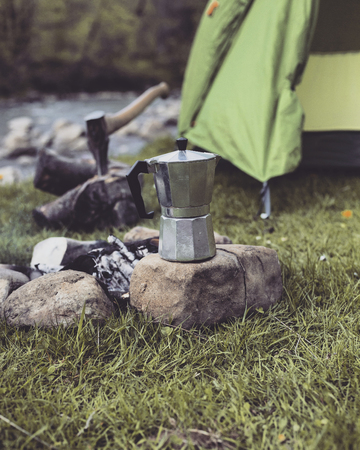Introduction: Why Go Eco-Friendly While Camping?
Camping is one of America’s favorite ways to enjoy the great outdoors, but it can also leave a surprising amount of waste behind. From single-use plastics to disposable utensils and packaging, traditional camping gear often ends up in landfills or pollutes beautiful natural spaces. This not only harms wildlife and plants but also takes away from the natural beauty campers seek in the first place.
Going eco-friendly while camping isn’t just a trend—it’s a way to protect nature for future generations. By choosing DIY, sustainable solutions for your camping gear, you can help cut down on waste and make your outdoor adventures more environmentally responsible. Creating your own reusable items at home not only reduces your environmental footprint but can also save money and add a personal touch to your gear.
The Environmental Impact of Camping Waste in America
| Common Camping Waste | Environmental Impact |
|---|---|
| Single-use plastics (bottles, utensils) | Take hundreds of years to decompose, pollute water and soil |
| Disposable food packaging | Attracts wildlife, leads to littering in campsites |
| Paper towels and napkins | Contribute to deforestation and landfill waste |
| Chemical-based cleaning products | Harmful runoff into rivers and lakes, damages ecosystems |
Benefits of DIY Eco-Friendly Camping Gear
- Saves Money: Reusable gear cuts down on buying disposables every trip.
- Reduces Waste: Keeps trash out of landfills and off trails.
- Adds Personalization: Custom gear fits your style and needs.
- Promotes Sustainable Habits: Encourages mindful consumption even beyond camping trips.
- Supports Community: Sharing DIY ideas with friends spreads eco-consciousness in the camping community.
If you love exploring America’s parks, forests, and wild spaces, making the switch to DIY eco-friendly gear is a simple yet powerful way to protect what you love. In the following sections, we’ll show you easy ways to create sustainable camping essentials that help cut down on waste while enhancing your outdoor experience.
2. Reusable Food & Drink Solutions
Why Go Reusable?
Single-use plastics and paper products are everywhere at campgrounds, but they create a lot of unnecessary waste. Switching to reusable food and drink solutions not only helps the environment, it also saves you money over time. Plus, these DIY options are fun to make and give your camping setup a personal touch that’s totally in style across U.S. campsites.
DIY Beeswax Wraps
Beeswax wraps are a fantastic replacement for plastic wrap or sandwich bags. They’re easy to make at home with just some cotton fabric, beeswax, and an oven.
How to Make Your Own Beeswax Wraps
| Materials | Instructions |
|---|---|
| Cotton fabric squares (8-12 inches) | Preheat oven to 200°F (93°C). Place fabric on parchment paper, sprinkle grated beeswax evenly, then bake until melted (about 5 minutes). Spread wax evenly with a brush, let cool and dry. |
| Beeswax pellets or grated beeswax | |
| Parchment paper & baking sheet | |
| Basting brush (optional) |
Use these wraps for sandwiches, cheese, fruits, or to cover bowls while camping.
Cloth Snack Bags & Sandwich Pouches
Ditch the disposable zip bags by sewing your own reusable snack pouches. All you need is some washable fabric and basic sewing skills.
Simple Steps for DIY Snack Bags
- Cut two rectangles of cotton fabric (about 7 x 9 inches).
- Sew the sides and bottom together, leaving the top open.
- Add velcro or snaps to keep snacks secure.
- Toss them in the wash when you get home—they’re ready for your next trip!
These bags are perfect for trail mix, cookies, fruit slices, or any snack you want to bring along without the waste.
Upcycled Water Bottles: A Campground Trend
Americans love their Nalgene bottles and stainless steel tumblers, but you can get creative by upcycling glass juice bottles or sturdy plastic bottles into reusable water containers. Decorate them with waterproof stickers or paint for a custom look.
| Reusable Bottle Ideas | Benefits |
|---|---|
| Mason jars with lids | Great for drinks and soups; easy to clean |
| Upcycled juice bottles | Saves money; keeps bottles out of landfills |
| Nalgene or stainless steel bottles | Durable; keeps drinks cold/hot longer; popular at U.S. campsites |
Pro Tips for U.S. Campers
- Avoid single-use cups—bring your own coffee mug or insulated tumbler.
- Packing a small bottle of eco-friendly soap makes washing reusables simple at the campground.
- If you forget your gear, many national parks have visitor centers or local shops offering sustainable options made by local artisans.
This hands-on approach not only reduces trash but also helps you stand out as an eco-conscious camper—a trend thats gaining momentum all across America!
![]()
3. DIY Natural Cleaning and Personal Care Kits
Keeping your camping trip eco-friendly means thinking beyond just what you eat or where you sleep—it also includes how you stay clean. By making your own natural cleaning and personal care kits, you can avoid single-use plastics, harsh chemicals, and unnecessary waste while still enjoying the great outdoors. Here’s how to make simple, effective, and earth-friendly alternatives for American campers who respect Leave No Trace principles.
Homemade Natural Soap
Making your own soap is easier than you think! Use ingredients that are gentle on your skin and biodegradable, so they won’t harm the environment when used outdoors.
| Ingredients | Instructions |
|---|---|
| – 1 cup liquid Castile soap – 1 tbsp baking soda – 10 drops essential oil (like lavender or tea tree) |
|
DIY Biodegradable Wipes
Instead of packing disposable wipes, make your own reusable version that’s easy on nature and your wallet.
| Materials | Instructions |
|---|---|
| – Soft cotton cloths or old t-shirts (cut into squares) – 1 cup distilled water – 2 tbsp aloe vera gel – 1 tbsp witch hazel – 5 drops essential oil (optional) |
|
Eco-Friendly Toiletries for Camping
You don’t have to give up comfort to go green. Here’s how to create planet-friendly essentials:
- Toothpaste: Mix 2 tbsp baking soda with a few drops of peppermint oil and enough water to form a paste. Store in a small jar.
- Mouthwash: Combine 1 cup water with 1 tsp baking soda and 4 drops peppermint oil. Shake before each use.
- Deodorant: Blend 2 tbsp coconut oil, 1 tbsp baking soda, and 1 tbsp cornstarch. Add a few drops of essential oil for scent if desired.
Packing Tips for Leave No Trace
- Use refillable travel-size containers instead of single-use plastics.
- Packs items in reusable bags or pouches.
- Always store soaps and toiletries away from rivers, lakes, and streams—at least 200 feet away—to protect wildlife and water quality.
Why Go DIY?
This approach not only reduces packaging waste but also lets you customize products based on your preferences and needs. Plus, it helps keep America’s wild spaces as pristine as you found them!
4. Creative Repurposing: Turning Everyday Items into Camp Gear
Camping doesn’t have to mean buying a bunch of new gear. With a little creativity, you can turn household waste and everyday items into useful tools for your next outdoor adventure. Not only does this save money, but it also helps reduce waste and gives old items a second life. Here are some fun and practical ways to repurpose things you might already have at home:
Tin Cans: More Than Just Trash
Don’t toss those empty soup or coffee cans! Tin cans are sturdy and versatile. Here are some ideas:
| Item | How to Repurpose | Camping Use |
|---|---|---|
| Tin Can | Punch holes around the top edge, add wire for a handle | DIY Lantern or Candle Holder (add a tealight) |
| Tin Can (large) | Clean thoroughly, remove label, smooth edges | Cooking Pot or Water Boiling Container |
| Tin Can Lid | Bend gently, sand edges smooth | Mini Spatula or Plate Scraper |
Old Clothes: Fabric with a New Purpose
If you have T-shirts, jeans, or flannel shirts that are too worn out to wear, don’t throw them away. Instead, try these:
- T-Shirt Bags: Cut off the sleeves and neck of an old tee, sew or tie the bottom closed—now you have a lightweight bag for carrying snacks or collecting kindling.
- Bandanas & Rags: Cut shirts or pants into squares for reusable napkins, dishcloths, or sweatbands.
- Padded Pouch: Use thick fabric from old jeans to make protective pouches for electronics or glasses while camping.
Jars: Storage Solutions on the Go
Mason jars and other glass containers can become must-have organizers for any trip:
| Jar Type | Repurposed Use | Description |
|---|---|---|
| Mason Jar (small) | Spice Holder/Condiment Kit | Pre-measure your favorite spices or sauces for easy camp cooking. |
| Mason Jar (large) | First Aid Kit Container | Keep bandages, ointments, and meds dry and organized. |
| Salsa/Jam Jar (cleaned) | Lanter Cover or Bug Catcher | Add a battery tea light for soft lighting or use as a safe bug collector for curious kids. |
Bottle Caps & Twist Ties: Don’t Overlook the Small Stuff!
Bottle caps can be used as emergency fire starters when filled with wax and a bit of cotton. Twist ties keep cords and gear bundled neatly. Save up these little helpers before your next trip—they’ll surprise you with their usefulness!
Your Turn!
The next time you’re about to recycle or toss something out, think about how it could serve you on your next camping trip. You’ll cut down on waste and create one-of-a-kind gear you can be proud of.
5. Tips for Minimizing Waste on American Campgrounds
When you’re camping in the U.S., keeping your environmental impact low is key to preserving the beautiful outdoors we all love. Here are some easy and practical tips for reducing waste while using your DIY eco-friendly camping gear:
Know Before You Go: Local Recycling & Trash Rules
Every campground has its own rules for trash and recycling. Some parks provide bins, while others expect you to pack everything out. Check the official website of your destination or call ahead to get the latest info.
| State/National Park | Recycling Provided? | Pack-Out Required? |
|---|---|---|
| Yosemite National Park (CA) | Yes (plastics, glass, cans) | Food scraps & non-recyclables |
| Great Smoky Mountains (TN/NC) | No | All trash must be packed out |
| Zion National Park (UT) | Yes (limited) | All trash must be packed out |
DIY Gear That Cuts Down on Waste
- Reusable utensils & plates: Bring your own set made from bamboo or stainless steel—skip disposables entirely.
- Homemade beeswax wraps: These are perfect for packing snacks instead of single-use plastic bags.
- Upcycled containers: Use jars or repurposed bottles for sauces and spices.
- Pocket-sized trash bag holders: Make one out of old fabric so you can always clean up after yourself and others.
Packing Tips: Leave No Trace Made Easy
- Sort your trash at camp: Set up separate bags or bins for recyclables, compostables, and landfill waste.
- Avoid excess packaging: Prep meals at home and use reusable containers instead of store packaging.
- Bottle refill stations: Many U.S. campgrounds have these—bring a sturdy water bottle to cut down on plastic use.
- Pocket ashtray: If you smoke, DIY a portable ashtray with a mint tin or film canister so you don’t leave cigarette butts behind.
Trash Pack-Out Etiquette 101
- If there are no dumpsters, take all your trash home—including food scraps and hygiene products.
- Aim to leave your site cleaner than you found it—pick up any litter you see, even if it’s not yours.
- Tie up bags securely to prevent wildlife from getting into them during transport.
Your Impact Matters!
The small steps you take with DIY gear and mindful habits make a big difference. By following local rules and packing smart, you’ll help protect America’s natural spaces for everyone to enjoy.


